University of Southern Queensland MGT8022: LSERR Project PMP Review
VerifiedAdded on 2023/06/12
|18
|4123
|379
Report
AI Summary
This report provides a critical evaluation of the Project Management Plan (PMP) for the Lower Solukhumbu Education Rebuild and Recovery Project (LSERR) initiated after the 2015 Nepal earthquakes. The analysis compares the PMP's structure and contents against established project management standards. While the PMP incorporates crucial elements like scope, quality, risk, and procurement management, it lacks a human resource management plan and stakeholder management strategy. The report identifies strengths and weaknesses within the plan, referencing guidelines from USQ and the NSW Government. Ultimately, the evaluation concludes that the PMP is well-structured but requires enhancements, offering specific recommendations to improve its comprehensiveness and effectiveness in guiding the LSERR project towards successful completion. Desklib provides access to similar solved assignments and project management resources for students.
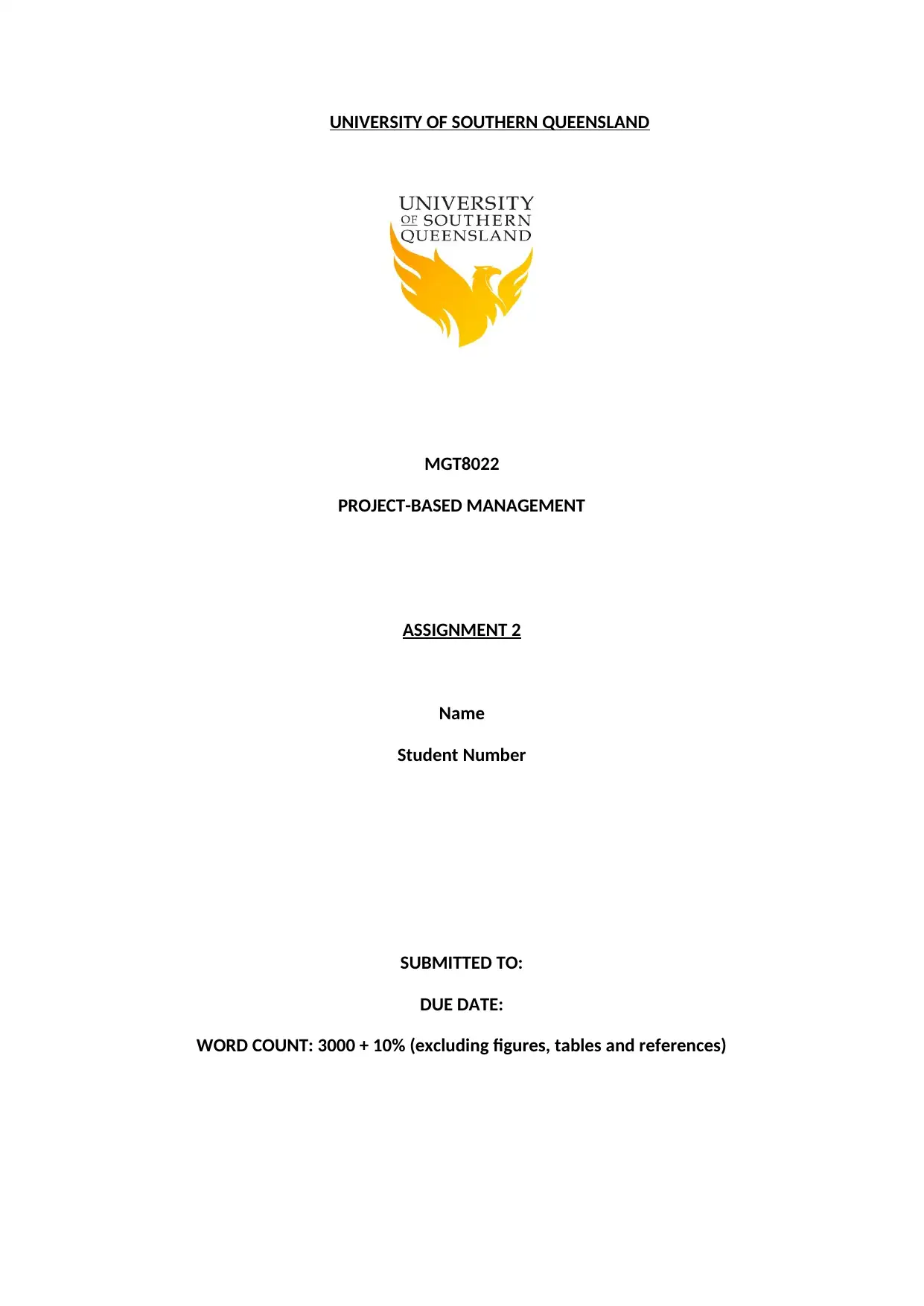
UNIVERSITY OF SOUTHERN QUEENSLAND
MGT8022
PROJECT-BASED MANAGEMENT
ASSIGNMENT 2
Name
Student Number
SUBMITTED TO:
DUE DATE:
WORD COUNT: 3000 + 10% (excluding figures, tables and references)
MGT8022
PROJECT-BASED MANAGEMENT
ASSIGNMENT 2
Name
Student Number
SUBMITTED TO:
DUE DATE:
WORD COUNT: 3000 + 10% (excluding figures, tables and references)
Paraphrase This Document
Need a fresh take? Get an instant paraphrase of this document with our AI Paraphraser
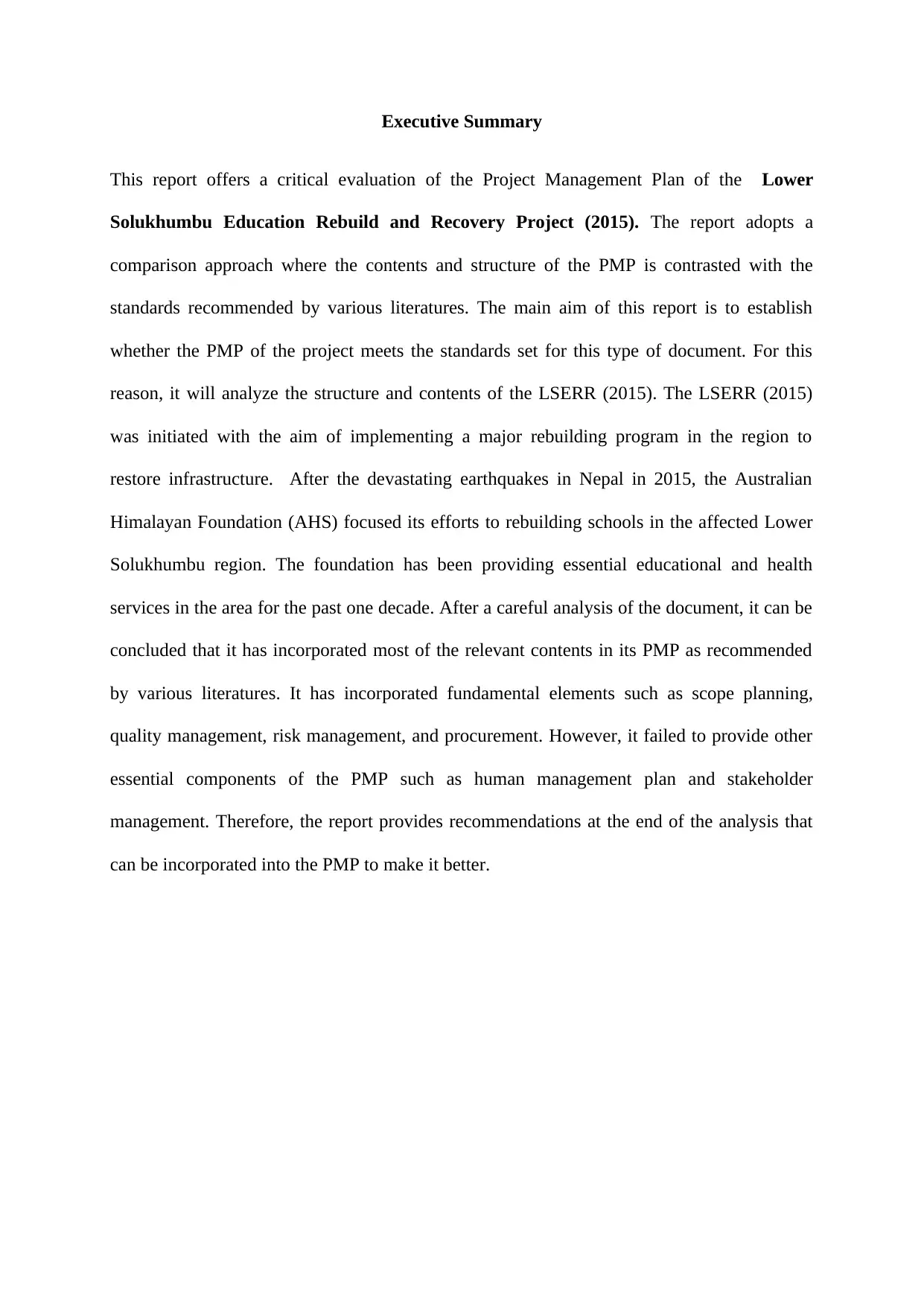
Executive Summary
This report offers a critical evaluation of the Project Management Plan of the Lower
Solukhumbu Education Rebuild and Recovery Project (2015). The report adopts a
comparison approach where the contents and structure of the PMP is contrasted with the
standards recommended by various literatures. The main aim of this report is to establish
whether the PMP of the project meets the standards set for this type of document. For this
reason, it will analyze the structure and contents of the LSERR (2015). The LSERR (2015)
was initiated with the aim of implementing a major rebuilding program in the region to
restore infrastructure. After the devastating earthquakes in Nepal in 2015, the Australian
Himalayan Foundation (AHS) focused its efforts to rebuilding schools in the affected Lower
Solukhumbu region. The foundation has been providing essential educational and health
services in the area for the past one decade. After a careful analysis of the document, it can be
concluded that it has incorporated most of the relevant contents in its PMP as recommended
by various literatures. It has incorporated fundamental elements such as scope planning,
quality management, risk management, and procurement. However, it failed to provide other
essential components of the PMP such as human management plan and stakeholder
management. Therefore, the report provides recommendations at the end of the analysis that
can be incorporated into the PMP to make it better.
This report offers a critical evaluation of the Project Management Plan of the Lower
Solukhumbu Education Rebuild and Recovery Project (2015). The report adopts a
comparison approach where the contents and structure of the PMP is contrasted with the
standards recommended by various literatures. The main aim of this report is to establish
whether the PMP of the project meets the standards set for this type of document. For this
reason, it will analyze the structure and contents of the LSERR (2015). The LSERR (2015)
was initiated with the aim of implementing a major rebuilding program in the region to
restore infrastructure. After the devastating earthquakes in Nepal in 2015, the Australian
Himalayan Foundation (AHS) focused its efforts to rebuilding schools in the affected Lower
Solukhumbu region. The foundation has been providing essential educational and health
services in the area for the past one decade. After a careful analysis of the document, it can be
concluded that it has incorporated most of the relevant contents in its PMP as recommended
by various literatures. It has incorporated fundamental elements such as scope planning,
quality management, risk management, and procurement. However, it failed to provide other
essential components of the PMP such as human management plan and stakeholder
management. Therefore, the report provides recommendations at the end of the analysis that
can be incorporated into the PMP to make it better.
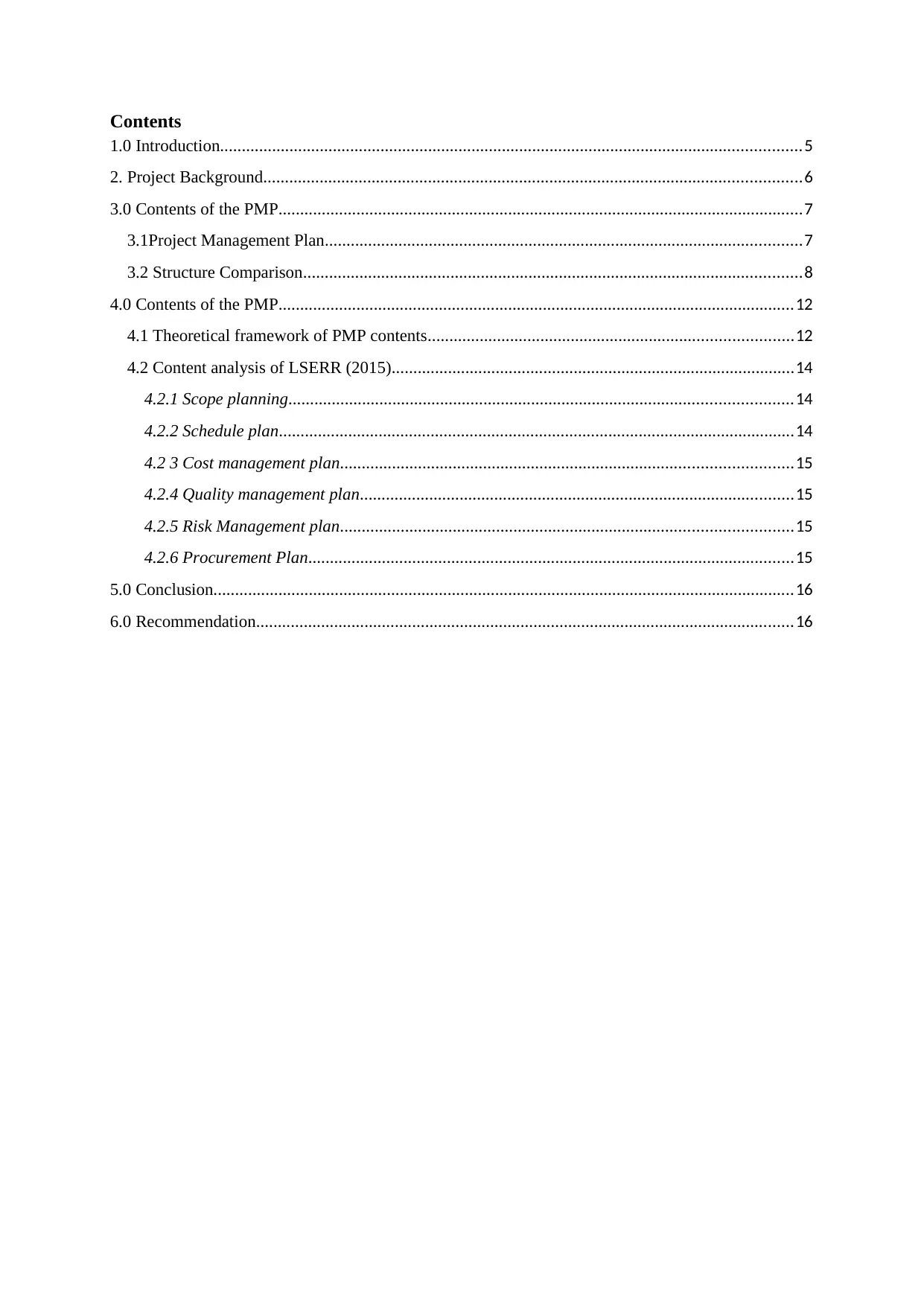
Contents
1.0 Introduction......................................................................................................................................5
2. Project Background............................................................................................................................6
3.0 Contents of the PMP.........................................................................................................................7
3.1Project Management Plan..............................................................................................................7
3.2 Structure Comparison...................................................................................................................8
4.0 Contents of the PMP.......................................................................................................................12
4.1 Theoretical framework of PMP contents....................................................................................12
4.2 Content analysis of LSERR (2015).............................................................................................14
4.2.1 Scope planning....................................................................................................................14
4.2.2 Schedule plan.......................................................................................................................14
4.2 3 Cost management plan........................................................................................................15
4.2.4 Quality management plan....................................................................................................15
4.2.5 Risk Management plan........................................................................................................15
4.2.6 Procurement Plan................................................................................................................15
5.0 Conclusion......................................................................................................................................16
6.0 Recommendation............................................................................................................................16
1.0 Introduction......................................................................................................................................5
2. Project Background............................................................................................................................6
3.0 Contents of the PMP.........................................................................................................................7
3.1Project Management Plan..............................................................................................................7
3.2 Structure Comparison...................................................................................................................8
4.0 Contents of the PMP.......................................................................................................................12
4.1 Theoretical framework of PMP contents....................................................................................12
4.2 Content analysis of LSERR (2015).............................................................................................14
4.2.1 Scope planning....................................................................................................................14
4.2.2 Schedule plan.......................................................................................................................14
4.2 3 Cost management plan........................................................................................................15
4.2.4 Quality management plan....................................................................................................15
4.2.5 Risk Management plan........................................................................................................15
4.2.6 Procurement Plan................................................................................................................15
5.0 Conclusion......................................................................................................................................16
6.0 Recommendation............................................................................................................................16
⊘ This is a preview!⊘
Do you want full access?
Subscribe today to unlock all pages.

Trusted by 1+ million students worldwide

List of Tables
Table 1: PMP definitions............................................................................................................5
Table 2: Theoretical Framework of PMP Structures..................................................................6
Table 3 Literature recommendations on the contents of a PMP...............................................11
Table 1: PMP definitions............................................................................................................5
Table 2: Theoretical Framework of PMP Structures..................................................................6
Table 3 Literature recommendations on the contents of a PMP...............................................11
Paraphrase This Document
Need a fresh take? Get an instant paraphrase of this document with our AI Paraphraser
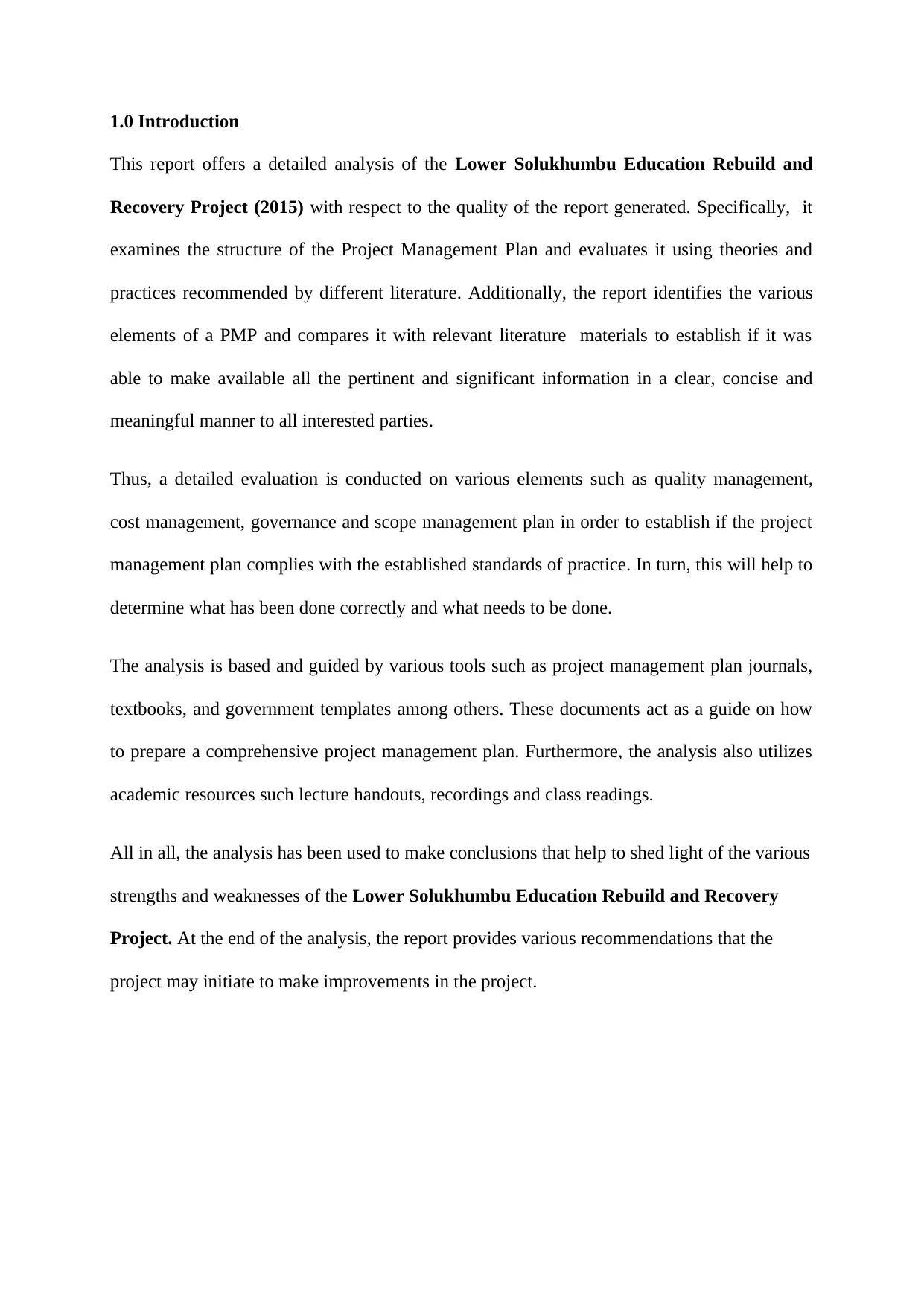
1.0 Introduction
This report offers a detailed analysis of the Lower Solukhumbu Education Rebuild and
Recovery Project (2015) with respect to the quality of the report generated. Specifically, it
examines the structure of the Project Management Plan and evaluates it using theories and
practices recommended by different literature. Additionally, the report identifies the various
elements of a PMP and compares it with relevant literature materials to establish if it was
able to make available all the pertinent and significant information in a clear, concise and
meaningful manner to all interested parties.
Thus, a detailed evaluation is conducted on various elements such as quality management,
cost management, governance and scope management plan in order to establish if the project
management plan complies with the established standards of practice. In turn, this will help to
determine what has been done correctly and what needs to be done.
The analysis is based and guided by various tools such as project management plan journals,
textbooks, and government templates among others. These documents act as a guide on how
to prepare a comprehensive project management plan. Furthermore, the analysis also utilizes
academic resources such lecture handouts, recordings and class readings.
All in all, the analysis has been used to make conclusions that help to shed light of the various
strengths and weaknesses of the Lower Solukhumbu Education Rebuild and Recovery
Project. At the end of the analysis, the report provides various recommendations that the
project may initiate to make improvements in the project.
This report offers a detailed analysis of the Lower Solukhumbu Education Rebuild and
Recovery Project (2015) with respect to the quality of the report generated. Specifically, it
examines the structure of the Project Management Plan and evaluates it using theories and
practices recommended by different literature. Additionally, the report identifies the various
elements of a PMP and compares it with relevant literature materials to establish if it was
able to make available all the pertinent and significant information in a clear, concise and
meaningful manner to all interested parties.
Thus, a detailed evaluation is conducted on various elements such as quality management,
cost management, governance and scope management plan in order to establish if the project
management plan complies with the established standards of practice. In turn, this will help to
determine what has been done correctly and what needs to be done.
The analysis is based and guided by various tools such as project management plan journals,
textbooks, and government templates among others. These documents act as a guide on how
to prepare a comprehensive project management plan. Furthermore, the analysis also utilizes
academic resources such lecture handouts, recordings and class readings.
All in all, the analysis has been used to make conclusions that help to shed light of the various
strengths and weaknesses of the Lower Solukhumbu Education Rebuild and Recovery
Project. At the end of the analysis, the report provides various recommendations that the
project may initiate to make improvements in the project.
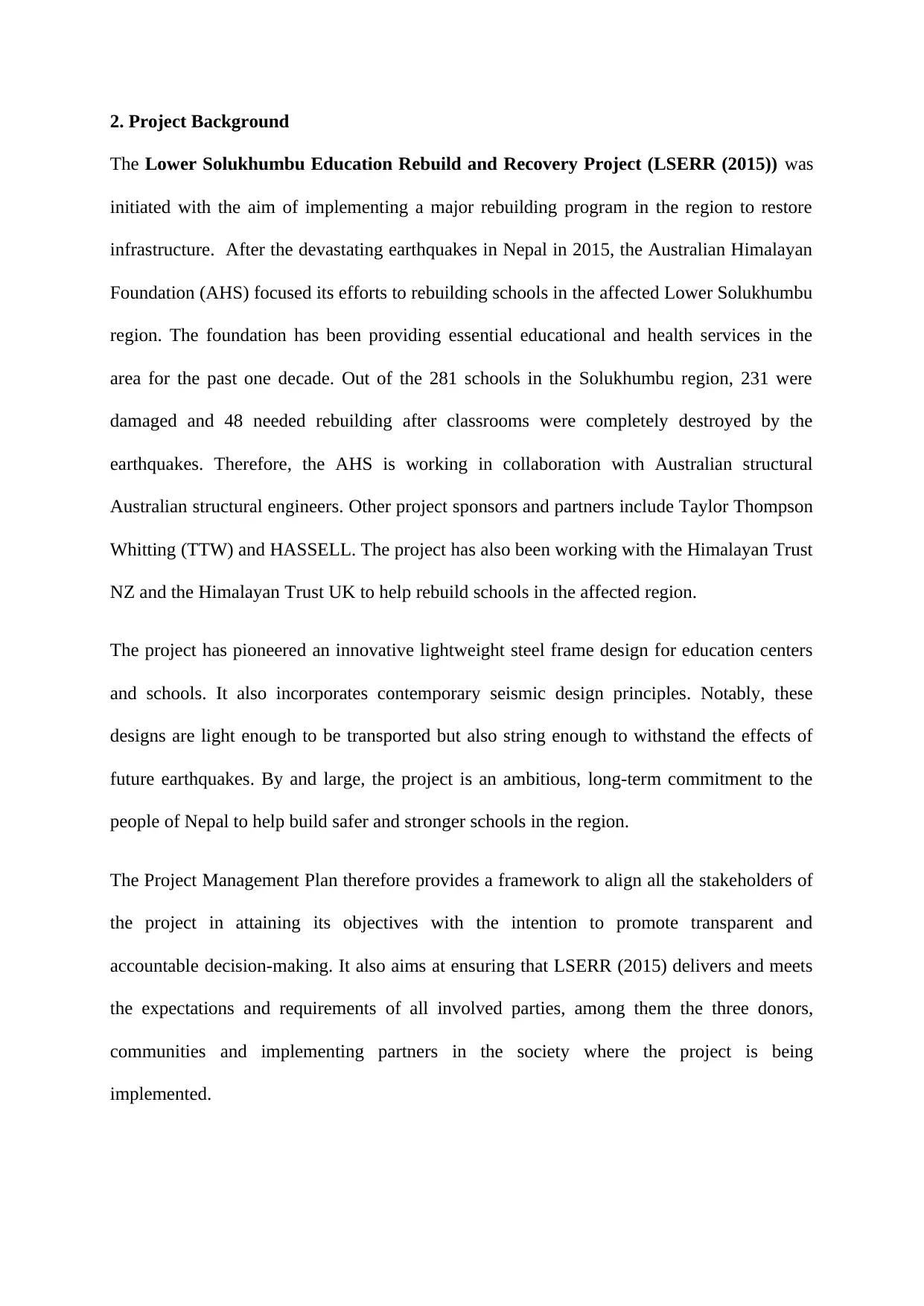
2. Project Background
The Lower Solukhumbu Education Rebuild and Recovery Project (LSERR (2015)) was
initiated with the aim of implementing a major rebuilding program in the region to restore
infrastructure. After the devastating earthquakes in Nepal in 2015, the Australian Himalayan
Foundation (AHS) focused its efforts to rebuilding schools in the affected Lower Solukhumbu
region. The foundation has been providing essential educational and health services in the
area for the past one decade. Out of the 281 schools in the Solukhumbu region, 231 were
damaged and 48 needed rebuilding after classrooms were completely destroyed by the
earthquakes. Therefore, the AHS is working in collaboration with Australian structural
Australian structural engineers. Other project sponsors and partners include Taylor Thompson
Whitting (TTW) and HASSELL. The project has also been working with the Himalayan Trust
NZ and the Himalayan Trust UK to help rebuild schools in the affected region.
The project has pioneered an innovative lightweight steel frame design for education centers
and schools. It also incorporates contemporary seismic design principles. Notably, these
designs are light enough to be transported but also string enough to withstand the effects of
future earthquakes. By and large, the project is an ambitious, long-term commitment to the
people of Nepal to help build safer and stronger schools in the region.
The Project Management Plan therefore provides a framework to align all the stakeholders of
the project in attaining its objectives with the intention to promote transparent and
accountable decision-making. It also aims at ensuring that LSERR (2015) delivers and meets
the expectations and requirements of all involved parties, among them the three donors,
communities and implementing partners in the society where the project is being
implemented.
The Lower Solukhumbu Education Rebuild and Recovery Project (LSERR (2015)) was
initiated with the aim of implementing a major rebuilding program in the region to restore
infrastructure. After the devastating earthquakes in Nepal in 2015, the Australian Himalayan
Foundation (AHS) focused its efforts to rebuilding schools in the affected Lower Solukhumbu
region. The foundation has been providing essential educational and health services in the
area for the past one decade. Out of the 281 schools in the Solukhumbu region, 231 were
damaged and 48 needed rebuilding after classrooms were completely destroyed by the
earthquakes. Therefore, the AHS is working in collaboration with Australian structural
Australian structural engineers. Other project sponsors and partners include Taylor Thompson
Whitting (TTW) and HASSELL. The project has also been working with the Himalayan Trust
NZ and the Himalayan Trust UK to help rebuild schools in the affected region.
The project has pioneered an innovative lightweight steel frame design for education centers
and schools. It also incorporates contemporary seismic design principles. Notably, these
designs are light enough to be transported but also string enough to withstand the effects of
future earthquakes. By and large, the project is an ambitious, long-term commitment to the
people of Nepal to help build safer and stronger schools in the region.
The Project Management Plan therefore provides a framework to align all the stakeholders of
the project in attaining its objectives with the intention to promote transparent and
accountable decision-making. It also aims at ensuring that LSERR (2015) delivers and meets
the expectations and requirements of all involved parties, among them the three donors,
communities and implementing partners in the society where the project is being
implemented.
⊘ This is a preview!⊘
Do you want full access?
Subscribe today to unlock all pages.

Trusted by 1+ million students worldwide
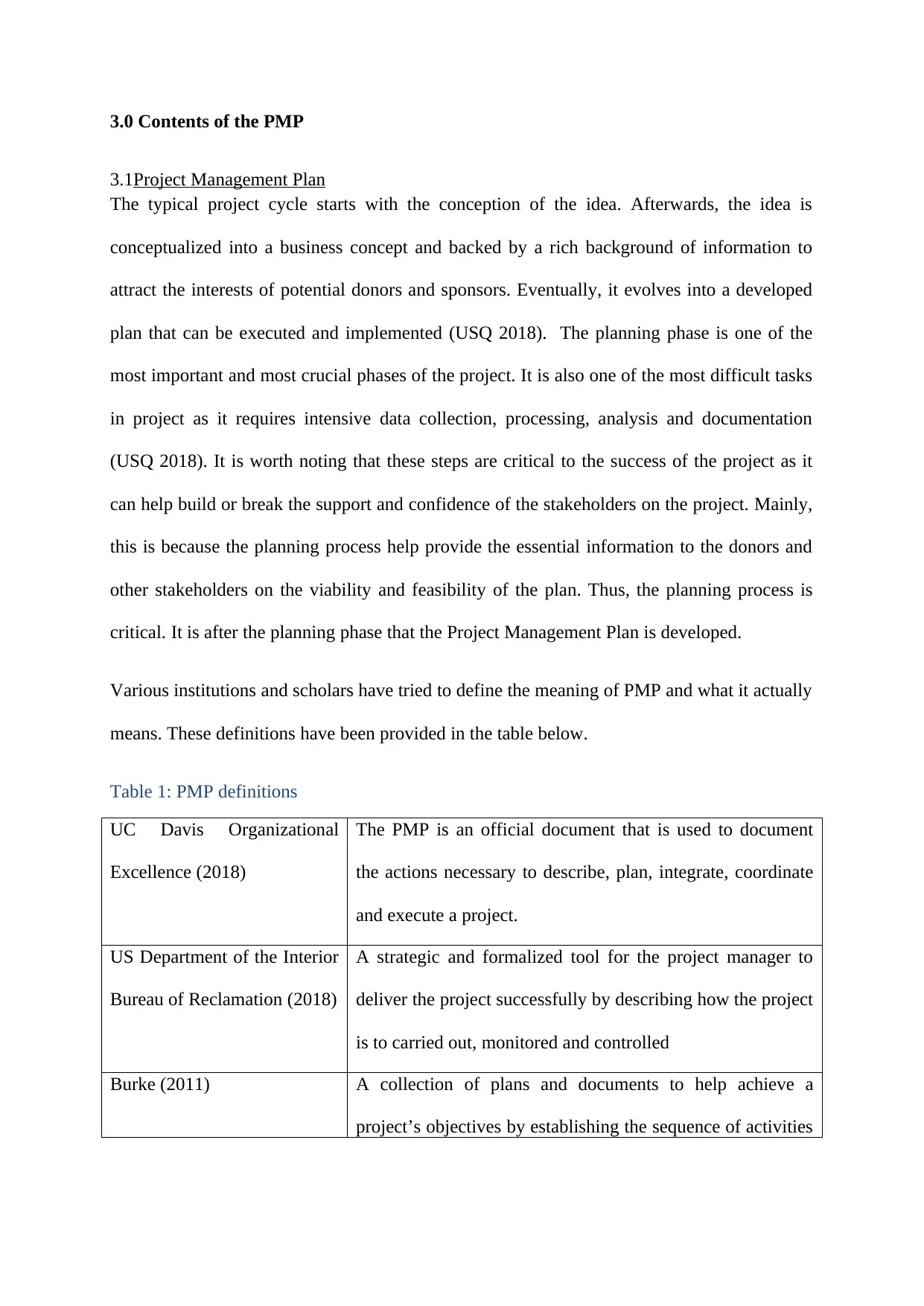
3.0 Contents of the PMP
3.1Project Management Plan
The typical project cycle starts with the conception of the idea. Afterwards, the idea is
conceptualized into a business concept and backed by a rich background of information to
attract the interests of potential donors and sponsors. Eventually, it evolves into a developed
plan that can be executed and implemented (USQ 2018). The planning phase is one of the
most important and most crucial phases of the project. It is also one of the most difficult tasks
in project as it requires intensive data collection, processing, analysis and documentation
(USQ 2018). It is worth noting that these steps are critical to the success of the project as it
can help build or break the support and confidence of the stakeholders on the project. Mainly,
this is because the planning process help provide the essential information to the donors and
other stakeholders on the viability and feasibility of the plan. Thus, the planning process is
critical. It is after the planning phase that the Project Management Plan is developed.
Various institutions and scholars have tried to define the meaning of PMP and what it actually
means. These definitions have been provided in the table below.
Table 1: PMP definitions
UC Davis Organizational
Excellence (2018)
The PMP is an official document that is used to document
the actions necessary to describe, plan, integrate, coordinate
and execute a project.
US Department of the Interior
Bureau of Reclamation (2018)
A strategic and formalized tool for the project manager to
deliver the project successfully by describing how the project
is to carried out, monitored and controlled
Burke (2011) A collection of plans and documents to help achieve a
project’s objectives by establishing the sequence of activities
3.1Project Management Plan
The typical project cycle starts with the conception of the idea. Afterwards, the idea is
conceptualized into a business concept and backed by a rich background of information to
attract the interests of potential donors and sponsors. Eventually, it evolves into a developed
plan that can be executed and implemented (USQ 2018). The planning phase is one of the
most important and most crucial phases of the project. It is also one of the most difficult tasks
in project as it requires intensive data collection, processing, analysis and documentation
(USQ 2018). It is worth noting that these steps are critical to the success of the project as it
can help build or break the support and confidence of the stakeholders on the project. Mainly,
this is because the planning process help provide the essential information to the donors and
other stakeholders on the viability and feasibility of the plan. Thus, the planning process is
critical. It is after the planning phase that the Project Management Plan is developed.
Various institutions and scholars have tried to define the meaning of PMP and what it actually
means. These definitions have been provided in the table below.
Table 1: PMP definitions
UC Davis Organizational
Excellence (2018)
The PMP is an official document that is used to document
the actions necessary to describe, plan, integrate, coordinate
and execute a project.
US Department of the Interior
Bureau of Reclamation (2018)
A strategic and formalized tool for the project manager to
deliver the project successfully by describing how the project
is to carried out, monitored and controlled
Burke (2011) A collection of plans and documents to help achieve a
project’s objectives by establishing the sequence of activities
Paraphrase This Document
Need a fresh take? Get an instant paraphrase of this document with our AI Paraphraser
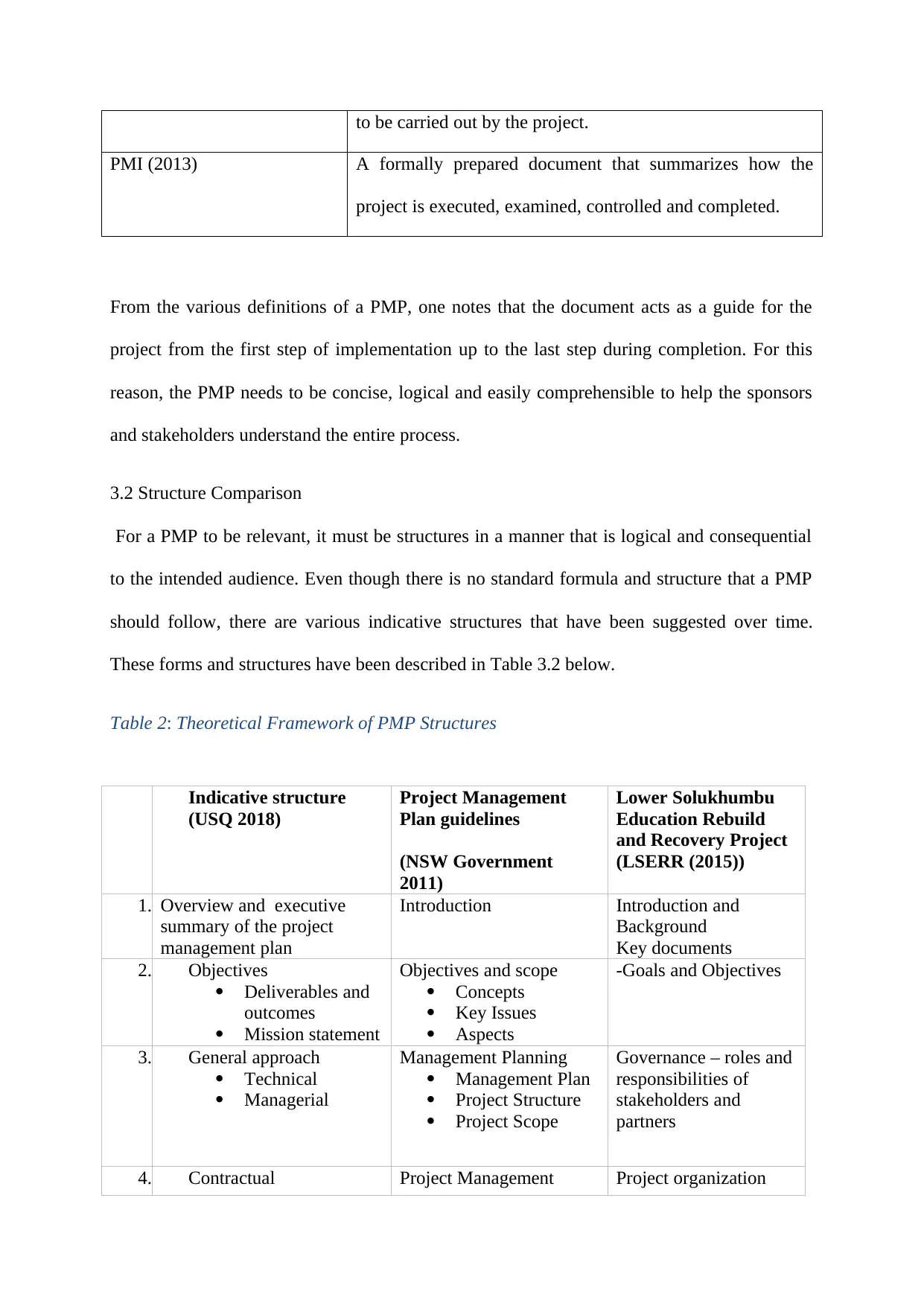
to be carried out by the project.
PMI (2013) A formally prepared document that summarizes how the
project is executed, examined, controlled and completed.
From the various definitions of a PMP, one notes that the document acts as a guide for the
project from the first step of implementation up to the last step during completion. For this
reason, the PMP needs to be concise, logical and easily comprehensible to help the sponsors
and stakeholders understand the entire process.
3.2 Structure Comparison
For a PMP to be relevant, it must be structures in a manner that is logical and consequential
to the intended audience. Even though there is no standard formula and structure that a PMP
should follow, there are various indicative structures that have been suggested over time.
These forms and structures have been described in Table 3.2 below.
Table 2: Theoretical Framework of PMP Structures
Indicative structure
(USQ 2018)
Project Management
Plan guidelines
(NSW Government
2011)
Lower Solukhumbu
Education Rebuild
and Recovery Project
(LSERR (2015))
1. Overview and executive
summary of the project
management plan
Introduction Introduction and
Background
Key documents
2. Objectives
Deliverables and
outcomes
Mission statement
Objectives and scope
Concepts
Key Issues
Aspects
-Goals and Objectives
3. General approach
Technical
Managerial
Management Planning
Management Plan
Project Structure
Project Scope
Governance – roles and
responsibilities of
stakeholders and
partners
4. Contractual Project Management Project organization
PMI (2013) A formally prepared document that summarizes how the
project is executed, examined, controlled and completed.
From the various definitions of a PMP, one notes that the document acts as a guide for the
project from the first step of implementation up to the last step during completion. For this
reason, the PMP needs to be concise, logical and easily comprehensible to help the sponsors
and stakeholders understand the entire process.
3.2 Structure Comparison
For a PMP to be relevant, it must be structures in a manner that is logical and consequential
to the intended audience. Even though there is no standard formula and structure that a PMP
should follow, there are various indicative structures that have been suggested over time.
These forms and structures have been described in Table 3.2 below.
Table 2: Theoretical Framework of PMP Structures
Indicative structure
(USQ 2018)
Project Management
Plan guidelines
(NSW Government
2011)
Lower Solukhumbu
Education Rebuild
and Recovery Project
(LSERR (2015))
1. Overview and executive
summary of the project
management plan
Introduction Introduction and
Background
Key documents
2. Objectives
Deliverables and
outcomes
Mission statement
Objectives and scope
Concepts
Key Issues
Aspects
-Goals and Objectives
3. General approach
Technical
Managerial
Management Planning
Management Plan
Project Structure
Project Scope
Governance – roles and
responsibilities of
stakeholders and
partners
4. Contractual Project Management Project organization
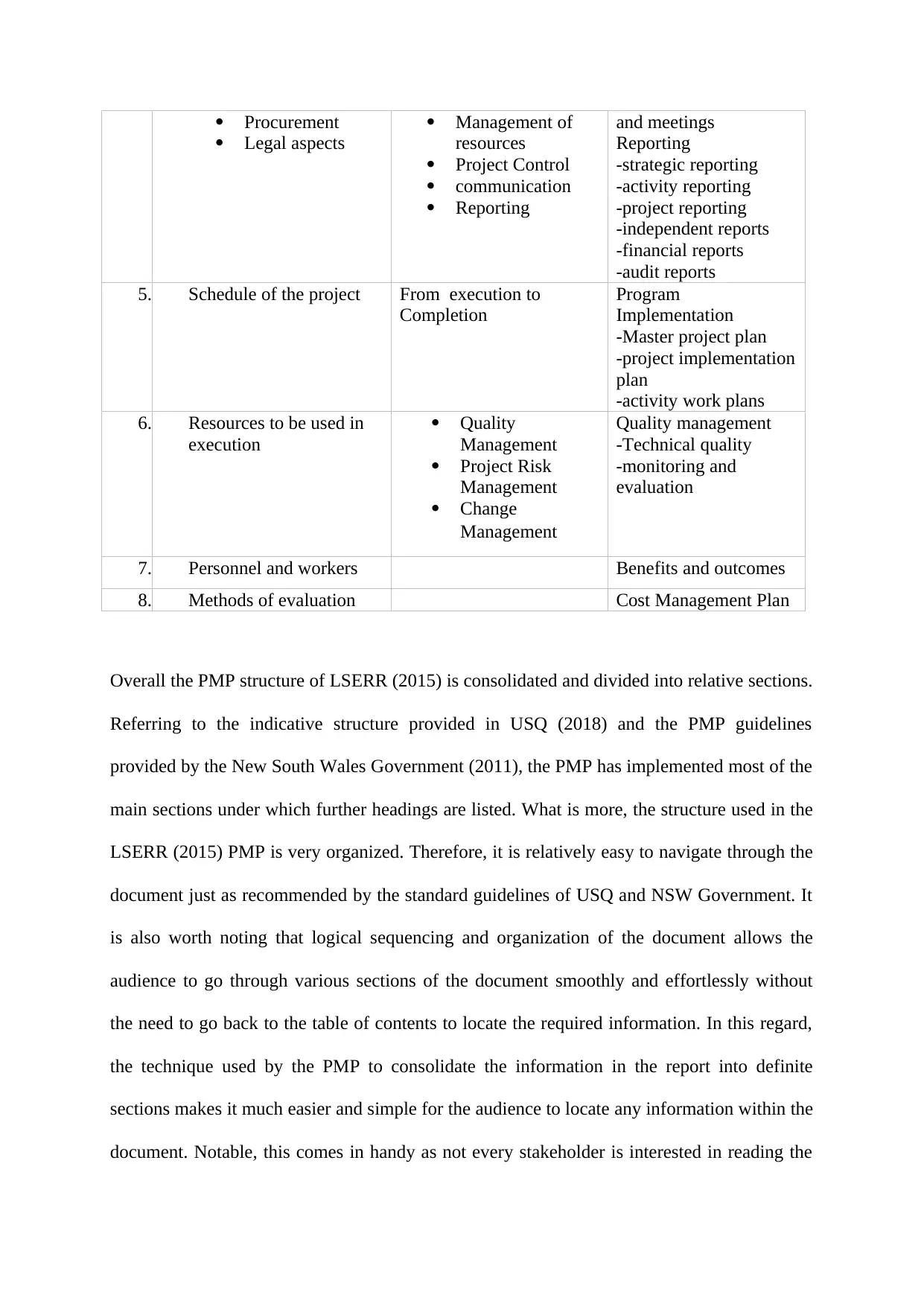
Procurement
Legal aspects
Management of
resources
Project Control
communication
Reporting
and meetings
Reporting
-strategic reporting
-activity reporting
-project reporting
-independent reports
-financial reports
-audit reports
5. Schedule of the project From execution to
Completion
Program
Implementation
-Master project plan
-project implementation
plan
-activity work plans
6. Resources to be used in
execution
Quality
Management
Project Risk
Management
Change
Management
Quality management
-Technical quality
-monitoring and
evaluation
7. Personnel and workers Benefits and outcomes
8. Methods of evaluation Cost Management Plan
Overall the PMP structure of LSERR (2015) is consolidated and divided into relative sections.
Referring to the indicative structure provided in USQ (2018) and the PMP guidelines
provided by the New South Wales Government (2011), the PMP has implemented most of the
main sections under which further headings are listed. What is more, the structure used in the
LSERR (2015) PMP is very organized. Therefore, it is relatively easy to navigate through the
document just as recommended by the standard guidelines of USQ and NSW Government. It
is also worth noting that logical sequencing and organization of the document allows the
audience to go through various sections of the document smoothly and effortlessly without
the need to go back to the table of contents to locate the required information. In this regard,
the technique used by the PMP to consolidate the information in the report into definite
sections makes it much easier and simple for the audience to locate any information within the
document. Notable, this comes in handy as not every stakeholder is interested in reading the
Legal aspects
Management of
resources
Project Control
communication
Reporting
and meetings
Reporting
-strategic reporting
-activity reporting
-project reporting
-independent reports
-financial reports
-audit reports
5. Schedule of the project From execution to
Completion
Program
Implementation
-Master project plan
-project implementation
plan
-activity work plans
6. Resources to be used in
execution
Quality
Management
Project Risk
Management
Change
Management
Quality management
-Technical quality
-monitoring and
evaluation
7. Personnel and workers Benefits and outcomes
8. Methods of evaluation Cost Management Plan
Overall the PMP structure of LSERR (2015) is consolidated and divided into relative sections.
Referring to the indicative structure provided in USQ (2018) and the PMP guidelines
provided by the New South Wales Government (2011), the PMP has implemented most of the
main sections under which further headings are listed. What is more, the structure used in the
LSERR (2015) PMP is very organized. Therefore, it is relatively easy to navigate through the
document just as recommended by the standard guidelines of USQ and NSW Government. It
is also worth noting that logical sequencing and organization of the document allows the
audience to go through various sections of the document smoothly and effortlessly without
the need to go back to the table of contents to locate the required information. In this regard,
the technique used by the PMP to consolidate the information in the report into definite
sections makes it much easier and simple for the audience to locate any information within the
document. Notable, this comes in handy as not every stakeholder is interested in reading the
⊘ This is a preview!⊘
Do you want full access?
Subscribe today to unlock all pages.

Trusted by 1+ million students worldwide
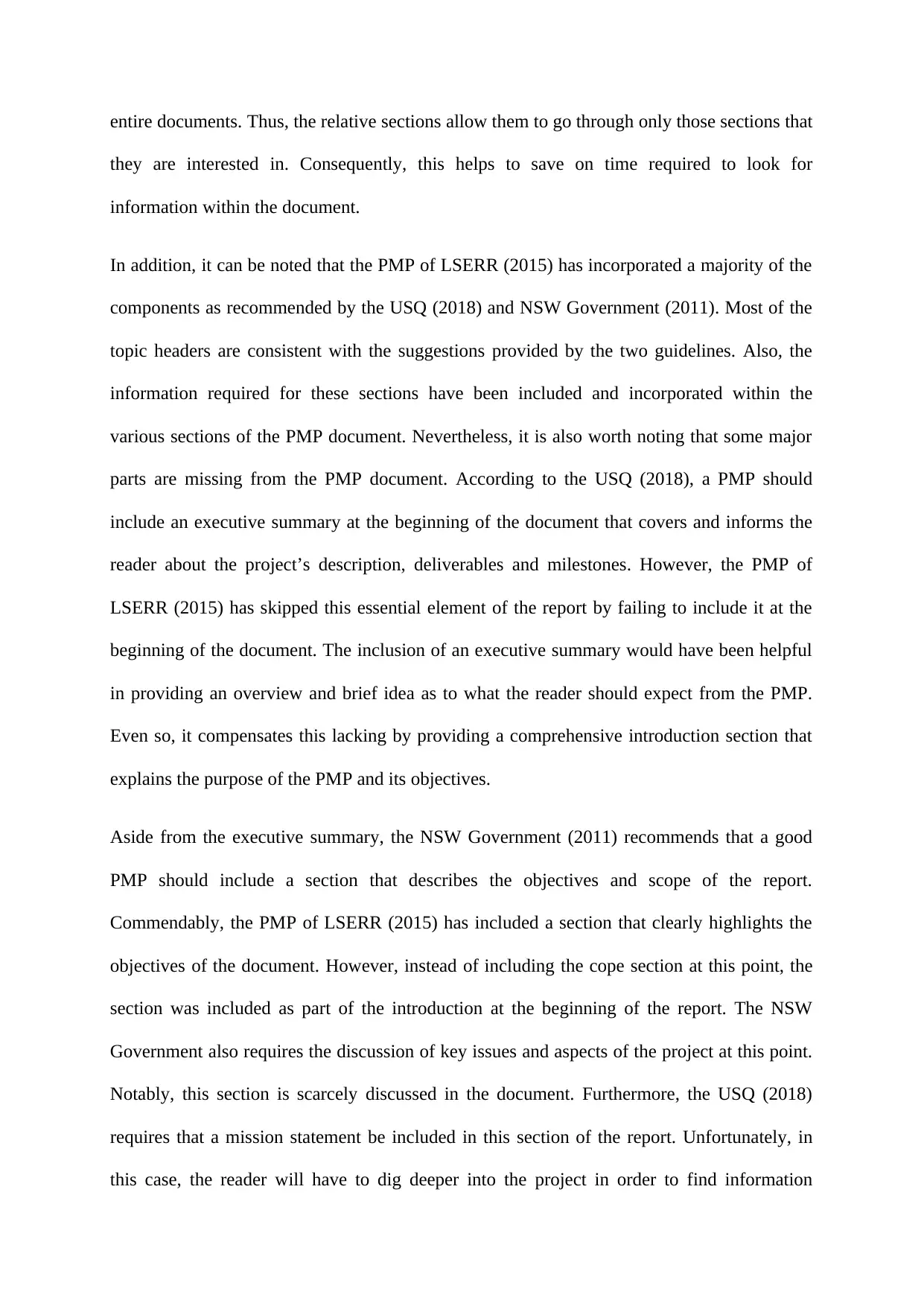
entire documents. Thus, the relative sections allow them to go through only those sections that
they are interested in. Consequently, this helps to save on time required to look for
information within the document.
In addition, it can be noted that the PMP of LSERR (2015) has incorporated a majority of the
components as recommended by the USQ (2018) and NSW Government (2011). Most of the
topic headers are consistent with the suggestions provided by the two guidelines. Also, the
information required for these sections have been included and incorporated within the
various sections of the PMP document. Nevertheless, it is also worth noting that some major
parts are missing from the PMP document. According to the USQ (2018), a PMP should
include an executive summary at the beginning of the document that covers and informs the
reader about the project’s description, deliverables and milestones. However, the PMP of
LSERR (2015) has skipped this essential element of the report by failing to include it at the
beginning of the document. The inclusion of an executive summary would have been helpful
in providing an overview and brief idea as to what the reader should expect from the PMP.
Even so, it compensates this lacking by providing a comprehensive introduction section that
explains the purpose of the PMP and its objectives.
Aside from the executive summary, the NSW Government (2011) recommends that a good
PMP should include a section that describes the objectives and scope of the report.
Commendably, the PMP of LSERR (2015) has included a section that clearly highlights the
objectives of the document. However, instead of including the cope section at this point, the
section was included as part of the introduction at the beginning of the report. The NSW
Government also requires the discussion of key issues and aspects of the project at this point.
Notably, this section is scarcely discussed in the document. Furthermore, the USQ (2018)
requires that a mission statement be included in this section of the report. Unfortunately, in
this case, the reader will have to dig deeper into the project in order to find information
they are interested in. Consequently, this helps to save on time required to look for
information within the document.
In addition, it can be noted that the PMP of LSERR (2015) has incorporated a majority of the
components as recommended by the USQ (2018) and NSW Government (2011). Most of the
topic headers are consistent with the suggestions provided by the two guidelines. Also, the
information required for these sections have been included and incorporated within the
various sections of the PMP document. Nevertheless, it is also worth noting that some major
parts are missing from the PMP document. According to the USQ (2018), a PMP should
include an executive summary at the beginning of the document that covers and informs the
reader about the project’s description, deliverables and milestones. However, the PMP of
LSERR (2015) has skipped this essential element of the report by failing to include it at the
beginning of the document. The inclusion of an executive summary would have been helpful
in providing an overview and brief idea as to what the reader should expect from the PMP.
Even so, it compensates this lacking by providing a comprehensive introduction section that
explains the purpose of the PMP and its objectives.
Aside from the executive summary, the NSW Government (2011) recommends that a good
PMP should include a section that describes the objectives and scope of the report.
Commendably, the PMP of LSERR (2015) has included a section that clearly highlights the
objectives of the document. However, instead of including the cope section at this point, the
section was included as part of the introduction at the beginning of the report. The NSW
Government also requires the discussion of key issues and aspects of the project at this point.
Notably, this section is scarcely discussed in the document. Furthermore, the USQ (2018)
requires that a mission statement be included in this section of the report. Unfortunately, in
this case, the reader will have to dig deeper into the project in order to find information
Paraphrase This Document
Need a fresh take? Get an instant paraphrase of this document with our AI Paraphraser
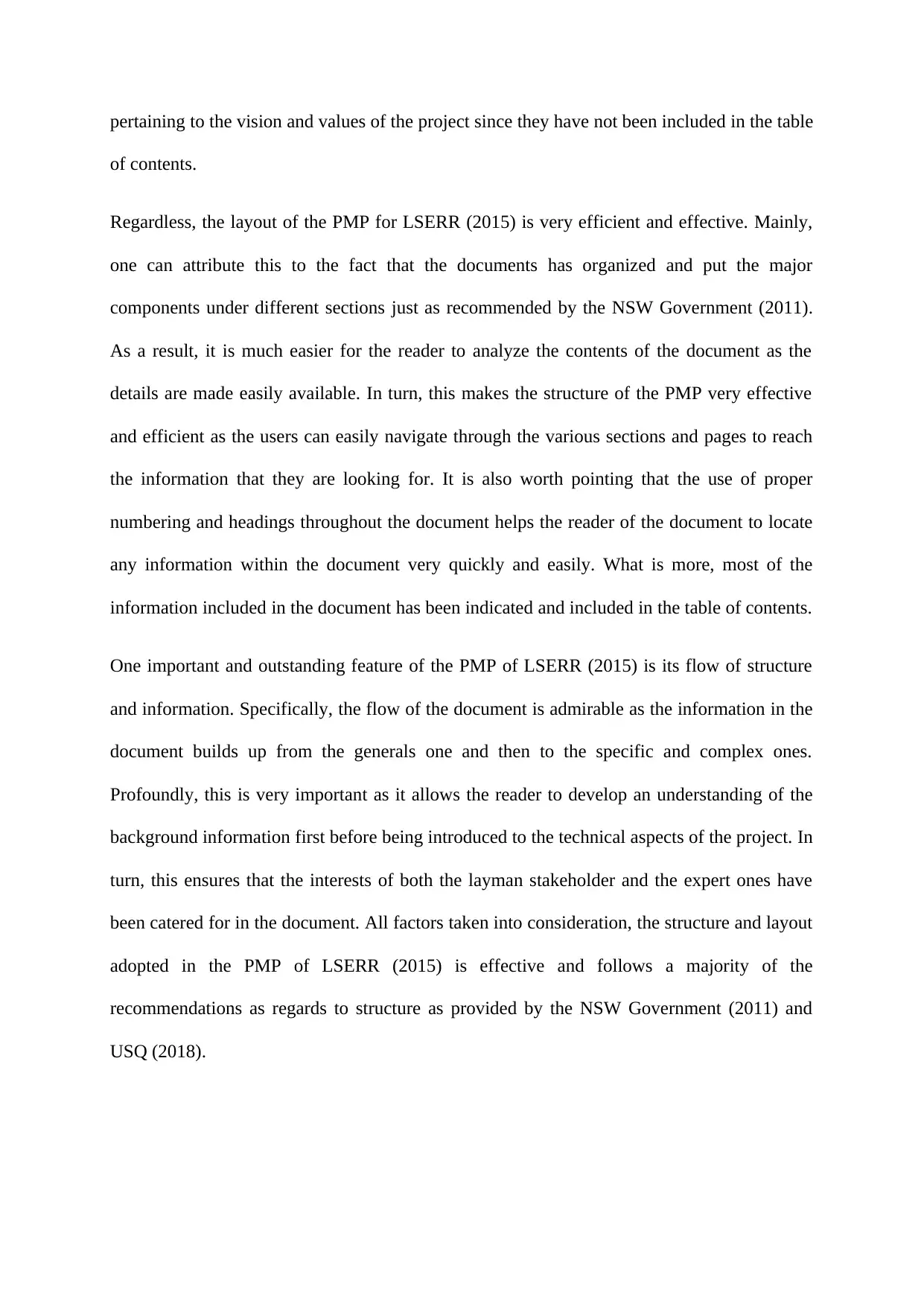
pertaining to the vision and values of the project since they have not been included in the table
of contents.
Regardless, the layout of the PMP for LSERR (2015) is very efficient and effective. Mainly,
one can attribute this to the fact that the documents has organized and put the major
components under different sections just as recommended by the NSW Government (2011).
As a result, it is much easier for the reader to analyze the contents of the document as the
details are made easily available. In turn, this makes the structure of the PMP very effective
and efficient as the users can easily navigate through the various sections and pages to reach
the information that they are looking for. It is also worth pointing that the use of proper
numbering and headings throughout the document helps the reader of the document to locate
any information within the document very quickly and easily. What is more, most of the
information included in the document has been indicated and included in the table of contents.
One important and outstanding feature of the PMP of LSERR (2015) is its flow of structure
and information. Specifically, the flow of the document is admirable as the information in the
document builds up from the generals one and then to the specific and complex ones.
Profoundly, this is very important as it allows the reader to develop an understanding of the
background information first before being introduced to the technical aspects of the project. In
turn, this ensures that the interests of both the layman stakeholder and the expert ones have
been catered for in the document. All factors taken into consideration, the structure and layout
adopted in the PMP of LSERR (2015) is effective and follows a majority of the
recommendations as regards to structure as provided by the NSW Government (2011) and
USQ (2018).
of contents.
Regardless, the layout of the PMP for LSERR (2015) is very efficient and effective. Mainly,
one can attribute this to the fact that the documents has organized and put the major
components under different sections just as recommended by the NSW Government (2011).
As a result, it is much easier for the reader to analyze the contents of the document as the
details are made easily available. In turn, this makes the structure of the PMP very effective
and efficient as the users can easily navigate through the various sections and pages to reach
the information that they are looking for. It is also worth pointing that the use of proper
numbering and headings throughout the document helps the reader of the document to locate
any information within the document very quickly and easily. What is more, most of the
information included in the document has been indicated and included in the table of contents.
One important and outstanding feature of the PMP of LSERR (2015) is its flow of structure
and information. Specifically, the flow of the document is admirable as the information in the
document builds up from the generals one and then to the specific and complex ones.
Profoundly, this is very important as it allows the reader to develop an understanding of the
background information first before being introduced to the technical aspects of the project. In
turn, this ensures that the interests of both the layman stakeholder and the expert ones have
been catered for in the document. All factors taken into consideration, the structure and layout
adopted in the PMP of LSERR (2015) is effective and follows a majority of the
recommendations as regards to structure as provided by the NSW Government (2011) and
USQ (2018).
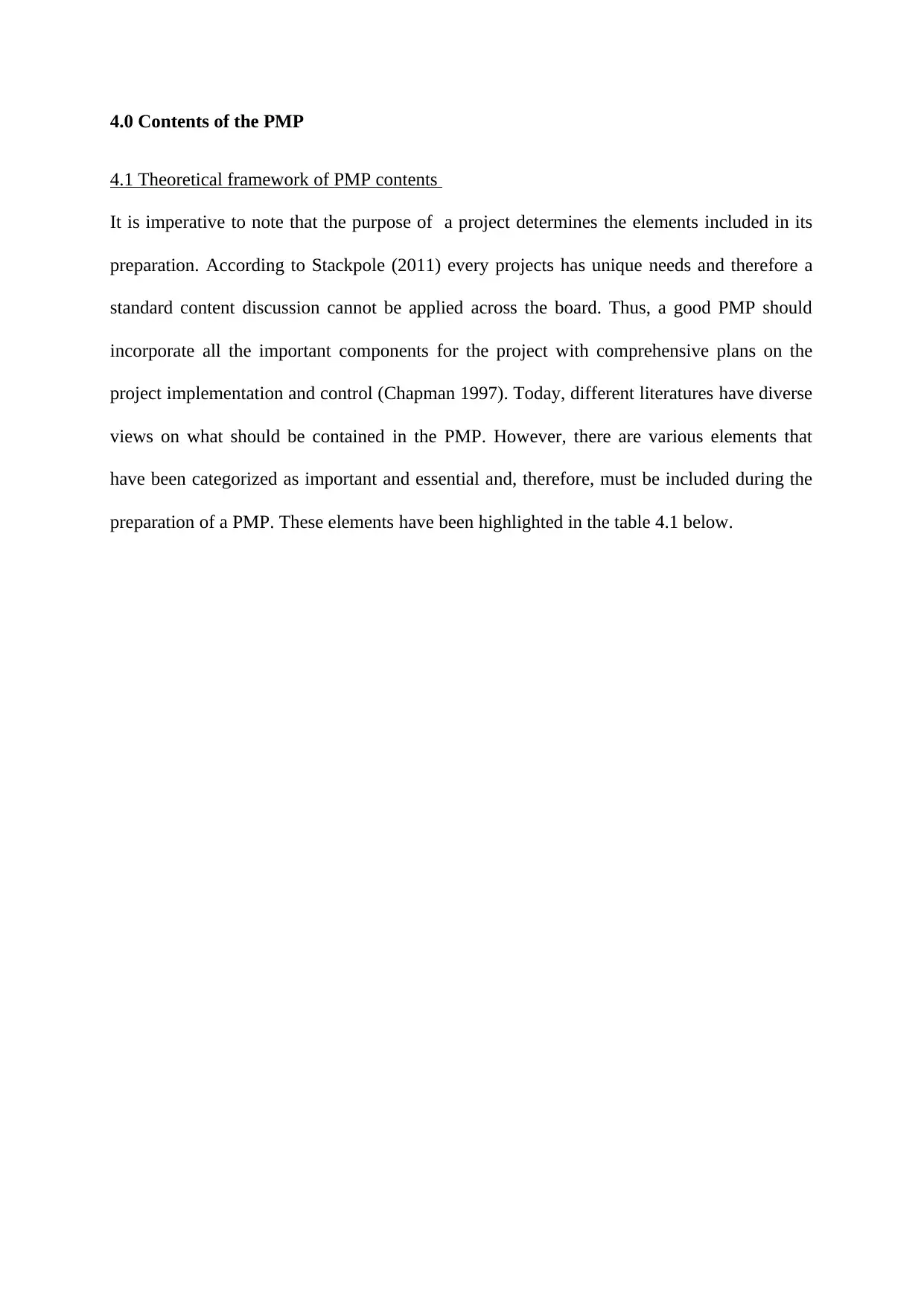
4.0 Contents of the PMP
4.1 Theoretical framework of PMP contents
It is imperative to note that the purpose of a project determines the elements included in its
preparation. According to Stackpole (2011) every projects has unique needs and therefore a
standard content discussion cannot be applied across the board. Thus, a good PMP should
incorporate all the important components for the project with comprehensive plans on the
project implementation and control (Chapman 1997). Today, different literatures have diverse
views on what should be contained in the PMP. However, there are various elements that
have been categorized as important and essential and, therefore, must be included during the
preparation of a PMP. These elements have been highlighted in the table 4.1 below.
4.1 Theoretical framework of PMP contents
It is imperative to note that the purpose of a project determines the elements included in its
preparation. According to Stackpole (2011) every projects has unique needs and therefore a
standard content discussion cannot be applied across the board. Thus, a good PMP should
incorporate all the important components for the project with comprehensive plans on the
project implementation and control (Chapman 1997). Today, different literatures have diverse
views on what should be contained in the PMP. However, there are various elements that
have been categorized as important and essential and, therefore, must be included during the
preparation of a PMP. These elements have been highlighted in the table 4.1 below.
⊘ This is a preview!⊘
Do you want full access?
Subscribe today to unlock all pages.

Trusted by 1+ million students worldwide
1 out of 18
Related Documents
Your All-in-One AI-Powered Toolkit for Academic Success.
+13062052269
info@desklib.com
Available 24*7 on WhatsApp / Email
![[object Object]](/_next/static/media/star-bottom.7253800d.svg)
Unlock your academic potential
Copyright © 2020–2025 A2Z Services. All Rights Reserved. Developed and managed by ZUCOL.





